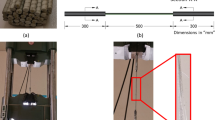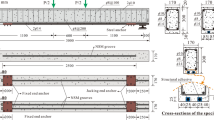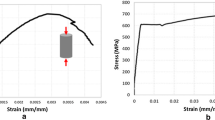Abstract
In this study, the effect of hollows passing through reinforced concrete (RC) beams in the longitudinal direction on flexural strength was examined. 4 RC beams were designed to satisfy the conditions for implementation. One of the beams was fabricated as a reference specimen and 3 of the remaining beams were fabricated with total of 5 pipes in the tension, neutral axis and compression regions. All experimental beam specimens were subjected to 4-point axial flexural tests with the request for constant flexural moments at the limits of loading. Experimental beams with pipes in the compression region, tensile region and neutral axis regions were confronted with the reference beam in terms of initial stiffness, ductility, load-bearing capacity and energy absorption capacity. It was verified that to provide that both the sufficient stiffness and sufficient ductility conditions for the reinforced concrete beams, do not establish any structural discontinuity, the longitudinal orbicular cross-section hollows created by pipes should be passed through the neutral axis region as much as possible. The results of the present study not only align with those of previous research (e.g., the correlative results) but also extend the current state of research (e.g., the revealed differences) and provide starting points for future research. Conclusions are drawn from these results at the end of the paper.
Similar content being viewed by others
Abbreviations
- a:
-
Depth of stress block
- A h :
-
Area of hollow portion
- A h′:
-
Area of hollow portion within the stress block
- A st :
-
Area of tensile reinforcement
- A t :
-
Area of transformed section
- a y :
-
Shear span
- a y/d :
-
Shear span to effective depth ratio
- b :
-
Breadth of the section
- b′:
-
Size of the equivalent square hole
- c :
-
Depth of neutral axis
- c′ :
-
Center of hole from top fiber
- C u :
-
Ultimate compression force for solid section
- C u1 :
-
Ultimate compression force for concrete at hollow section
- C u2 :
-
Ultimate compression force for hole at hollow section
- D :
-
Overall depth
- d :
-
Effective depth
- f cr :
-
Rupture modulus value of concrete
- f y :
-
Steel yield strength
- I cr :
-
Inertia moment of cracked section
- I ucr :
-
Inertia moment of uncracked section
- m :
-
Modular ratio
- M cr :
-
Cracking moment
- M u :
-
Ultimate moment
- T u :
-
Ultimate tensile force
- W cr :
-
Cracking load
- (W cr)E :
-
Experimental cracking load
- (W cr)T :
-
Theoretical cracking load
- W u :
-
Ultimate load
- (W u)E :
-
Experimental ultimate load
- (W u)T :
-
Theoretical ultimate load
- y :
-
Depth of hollow portion
- σ cu :
-
Ultimate cube compression strength of concrete
- ϕ :
-
Hole’s diameter
References
Abbas RM, Fadala WA (2021) Behavioral investigation of reinforced concrete T-beams with distributed reinforcement in the tension flange. In E3S Web of Conferences 318:03010, EDP Sciences, DOI: https://doi.org/10.1051/e3sconf/202131803010
Abbas RM, Hussein LT (2023) Transient response and performance of prestressed concrete deep T-beams with large web openings under impact loading. Journal of the Mechanical Behavior of Materials 32(1):20220268, DOI: https://doi.org/10.1515/jmbm-2022-0268
Abdalla H, Kennedy JB (1995) Design of prestressed concrete beams with openings. Journal of Structural Engineering 121(5):890–898, DOI: https://doi.org/10.1061/(ASCE)0733-9445(1995)121:5(890)
Abdel-kareem AH, Salam AE (2020) Experimental and analytical investigation of reinforced concrete beams with large web opening under pure torsion. International Journal of Advanced Engineering, Management and Science 6(1):18–33, DOI: https://doi.org/10.22161/ijaems.61.4
Acar A (2004) Project reading, formwork preparation, rebar binding and concrete course notes. TMMOB Department of İzmir Publications, İzmir, Turkey
Ahmed A, Fayyadh MM, Naganathan S, Nasharuddin K (2012) Reinforced concrete beams with web openings: A state of the art review. Materials and Design 40:90–102, DOI: https://doi.org/10.1016/j.matdes.2012.03.001
Albegmprli HM, Gülşan ME, Cevik A (2019) Comprehensive experimental investigation on mechanical behavior for types of reinforced concrete Haunched beam. Advances in Concrete Construction 7(1): 39, DOI: https://doi.org/10.12989/acc.2019.7.1.039
Amiri S, Masoudnia R (2011) Investigation of the opening effects on the behavior of concrete beams without additional reinforcement in opening region using fem method. Australian Journal of Basic and Applied Sciences 5(5):617–627
ASTM C 39-01 (2001) Standard test method for compressive strength of cylindrical Concrete specimens. American Society for Testing and Materials; Philadelphia, USA
Bolideh A, Arab HG, Ghasemi MR (2019) A fast and robust procedure for optimal detail design of continuous RC beams. Computers and Concrete, An International Journal 24(4):313–327, DOI: https://doi.org/10.12989/cac.2019.24.4.313
Bower JE (1966) Experimental stresses in wide-flange beams with holes. Journal of the Structural Division 92(5):167–186, DOI: https://doi.org/10.1061/JSDEAG0001507
Cho SH, Redwood RG (1992a) Slab behavior in composite beams at opening, I: Analysis. Journal of Structural Engineering 118(9):2287–2303, DOI: https://doi.org/10.1061/(ASCE)0733-9445(1992)118:9(2287)
Cho SH, Redwood RG (1992b) Slab behavior in composite beams at opening, II: Tests and verification. Journal of Structural Engineering 118(9):2304–2322, DOI: https://doi.org/10.1061/(ASCE)0733-9445(1992)118:9(2304)
Darwin D, Lucas WK (1990) LRFD for steel and composite beams with web openings. Journal of Structural Engineering 116(6):1579–1593, DOI: https://doi.org/10.1061/(ASCE)0733-9445(1990)116:6(1579)
Du H, Hu X, Shi D, Fang B (2021) Effect of reinforcement on the strength of the web opening in steel-concrete composite beam. Engineering Structures 235:112038, DOI: https://doi.org/10.1016/j.engstruct.2021.112038
El Ame F, Mwero JN, Kabubo CK (2020) Openings effect on the performance of reinforced concrete beams loaded in bending and shear. Engineering, Technology and Applied Science Research 10(2), DOI: https://doi.org/10.48084/etasr.3317
Erim S, Uyaner M (1999) Stress distributions and stress concentration factors in a simple beam with a circular hole subjected to constant bending moment. Journal of Engineering Sciences 67(1):65–78
Ferreira FPV, Martins CH, De Nardin S (2020) Advances in composite beams with web openings and composite cellular beams. Journal of Constructional Steel Research 172:106182, DOI: https://doi.org/10.1016/j.jcsr.2020.106182
Ghuku S, Saha KN (2016) An experimental study on stress concentration around a hole under combined bending and stretching stress field. Procedia Technology 23:20–27, DOI: https://doi.org/10.1016/j.protcy.2016.03.068
Heller SR (1951) Reinforced circular holes in bending with shear. PhD Dissertation, Massachusetts Institute of Technology, Cambridge, MA
Husain M, Gheith H, Abdel-Megeed S, Zaki E (2017) Behavior of prestressed concrete beams with openings in Shear Region. The Egyptian International Journal of Engineering Sciences and Technology 23:21–31, DOI: https://doi.org/10.21608/eijest.2017.97199
Jabbar S, Hejazi F, Mahmod HM (2016) Effect of an opening on reinforced concrete hollow beam web under torsional, flexural, and cyclic loadings. Latin American Journal of Solids and Structures 13: 1576–1595, DOI: https://doi.org/10.1590/1679-782512629
James KW, James GM (2011) Reinforced concrete mechanics and design. 6th ed. Upper Saddle River, NJ: Prentice-Hall
Kalkan I, Ceylan E, Kartal S, Baran M (2021) Deflections of reinforced concrete beams with transverse openings of different geometries. Structural Engineering and Mechanics 80(3):323–339, DOI: https://doi.org/10.12989/sem.2021.80.3.323
Latha MS, Kumar BN (2017) Behavior of reinforced concrete beam with opening. International Journal of Civil Engineering and Technology (IJCIET) 8(7):581–593, http://www.iaeme.com/ijciet/issues.asp?JType=IJCIET&VType=8&IType=7
Mansur MA (1998) Effect of openings on the behaviour and strength of R/C beams in shear. Cement and Concrete Composites 20(6):477–486, DOI: https://doi.org/10.1016/S0958-9465(98)00030-4
Mansur MA (1999) Design of reinforced concrete beams with small openings under combined loading. ACI Structural Journal 96(5):675–682
Mansur MA (2006, September) Design of reinforced concrete beams with web openings. Proceedings of the 6th Asia-Pacific Structural Engineering and Construction Conference (ASPEC 2006), 5–6, Malaysia: Kuala Lumpur
McCormac JC, Brown RH (2015) Design of reinforced concrete. John Wiley and Sons, New York
Murugesan A, Narayanan A (2017) Influence of a longitudinal circular hole on flexural strength of reinforced concrete beams. Practice Periodical on Structural Design and Construction 22(2):1–10, DOI: https://doi.org/10.1061/(ASCE)SC.1943-5576.0000307
Nawy EG (2008) Concrete construction engineering handbook. (2nd ed.), CRC Press, Boca Raton
Parol J, Ben-Nakhi A, Al-Sanad S, Al-Qazweeni J, Al-Duaij HJ, Kamal H (2019) Experimental and numerical investigation of reinforced concrete beams containing vertical openings. Structural Engineering and Mechanics 72(3):383–393, DOI: https://doi.org/10.12989/sem.2019.72.3.383
Prentzas EG (1968) Behavior and reinforcement of concrete beams with large rectangular apertures. PhD Thesis, University of Sheffield, Sheffield, UK
Redwood RG, Pournbouras G (1984) Analysis of composite beams with web openings. Journal of Structural Engineering 110(9):1949–1958, DOI: https://doi.org/10.1061/(ASCE)0733-9445(1984)110:9(1949)
Redwood RG, Cho SH (1992) Design of steel and composite beams with web openings. Journal of Constructional Steel Research 25(1–2):23–41, DOI: https://doi.org/10.1016/0143-974X(93)90050-3
Saiyan S, Paushkin A (2021) Parametric study of the stress state of beams with round holes in pure bending. IOP Conference Series: Materials Science and Engineering 1015(1):012014, DOI: https://doi.org/10.1088/1757-899X/1015/1/012014
Savin GN (1961) Stress concentration around holes. Pergamon Press, New York, USA
Somes NF, Corley WG (1974) Circular openings in webs of continuous beams. Shear in Reinforced Concrete, Special Publication SP-42, American Concrete Institute, Detroit 42:359–398
Sweeney G, Salawdeh S (2020) Design of reinforced concrete beams with web openings. Civil Engineering Research in Ireland 2020, 3, https://sword.cit.ie/ceri/2020/8/3
TS 500 (2002) Requirements for design and construction of reinforced concrete structures. Turkish Standards Institute; Ankara, Turkey
TS 708 (2010) Steel for the reinforcement of concrete-reinforcing steel. Turkish Standard Institute; Ankara, Turkey
Todd DM, Cooper PB (1980) Strength of composite beams with web openings. Journal of the Structural Division 106(2):431–444, DOI: https://doi.org/10.1061/JSDEAG.0005366
Whitney CS (1942) Plastic theory of reinforced concrete design. ASCE Transactions of the American Society of Civil Engineers 107(1):251–326, DOI: https://doi.org/10.1061/TACEAT.0005554
Zivari A, Habibi A, Khaledy N (2019) Development of an analytical method for optimum design of reinforced concrete beams considering both flexural and shear effects. Computers and Concrete, An International Journal 24(2):117–123, DOI: https://doi.org/10.12989/cac.2019.24.2.117
Acknowledgments
This study is attributed to the thesis of Emre Korkmaz, a graduate student at Erzincan Binali Yıldırım University Civil Engineering Department. Author 1 and Author 2 contributed equally to this work. Within the scope of the study, we would like to thank Assoc Prof. Dr. Hakan Yaciner, Research Assistant Ahmet Ihsan Turan, Research Assistant Alper Celik and graduate student Umytjan Yangibayev for their contribution and support during all phases of the research.
Author information
Authors and Affiliations
Corresponding author
Rights and permissions
About this article
Cite this article
Kumbasaroglu, A., Korkmaz, E. Effect of Longitudinal Circular Hollows on the Flexural Strength of Reinforced Concrete Beams. KSCE J Civ Eng 28, 275–287 (2024). https://doi.org/10.1007/s12205-023-0424-2
Received:
Revised:
Accepted:
Published:
Issue Date:
DOI: https://doi.org/10.1007/s12205-023-0424-2




